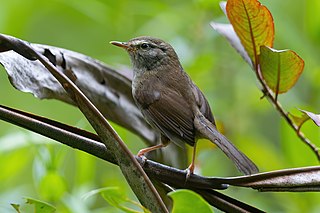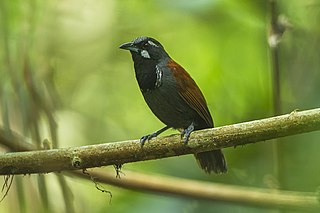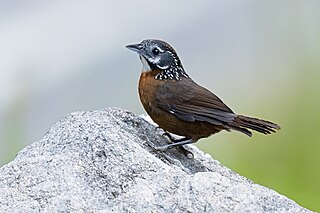
The pin-striped tit-babbler, also known as the yellow-breasted babbler, is a species of bird in the Old World babbler family Timaliidae that is found in South and Southeast Asia.

The aberrant bush warbler is a species in the bush warbler family, Cettiidae. It was formerly included in the "Old World warbler" assemblage.

The large hawk-cuckoo is a species of cuckoo in the family Cuculidae. It has a wide breeding distribution from temperate Asia along the Himalayas extending to East Asia. Many populations winter further south. They are known for their loud and repetitive calls which are similar to that of the common hawk-cuckoo but do not rise in crescendo. They are also somewhat larger and adults can be readily told apart from the smaller common hawk-cuckoo by the black patch on the chin. They are brood-parasites of babblers and laughing-thrushes.

The yellow-bellied bulbul is a species of songbird in the bulbul family, Pycnonotidae. It is found on the Malay Peninsula, Sumatra and Borneo. Its natural habitat is subtropical or tropical moist lowland forests.

The brown fulvetta is a species of bird in the family Alcippeidae. It is found in Brunei, Indonesia, Malaysia, and Thailand. Its natural habitat is subtropical or tropical moist lowland forest. It is threatened by habitat loss.

The ruby-cheeked sunbird is a species of sunbird in the family Nectariniidae.

The fluffy-backed tit-babbler is a species of bird in the family Timaliidae. It is found in Brunei, Indonesia, Malaysia, and Thailand. Its natural habitats are subtropical or tropical moist lowland forest and subtropical or tropical swampland. It is threatened by habitat loss.

Abbott's babbler is a species of bird in the family Pellorneidae. It is widely distributed along the Himalayas in South Asia and extending into the forests of Southeast Asia. They are short-tailed and stout birds which forage in pairs in dense undergrowth close to the ground and their presence is indicated by their distinctive calls.

The marbled wren-babbler is a species of bird in the family Pellorneidae. It is found in the Malay Peninsula and the Barisan Mountains of Sumatra. Its natural habitats are subtropical or tropical moist lowland forest and subtropical or tropical moist montane forest.

The large niltava is a species of bird in the Old world flycatcher family Muscicapidae. It is found in Bangladesh, Bhutan, Cambodia, China, India, Indonesia, Laos, Malaysia, Myanmar, Nepal, Thailand and Vietnam. Its natural habitat is subtropical or tropical montane forests.

The rusty-naped pitta is a species of bird in the family Pittidae.

The Sikkim wedge-billed babbler or blackish-breasted babbler is a species of bird in the Old World babbler family (Timaliidae). It is named for the Indian state of Sikkim.

Stachyris is a genus of passerine birds in the Old World babbler family Timaliidae.

The golden babbler is a babbler species in the family Timaliidae. It occurs from the foothills of the Eastern Himalayas to Southeast Asia and inhabits subtropical lowland and montane forests. It is listed as Least Concern on the IUCN Red List because of its wide distribution.

The chestnut-winged babbler is a babbler species in the family Timaliidae. It occurs in the Malay Peninsula from southern Thailand to Singapore, and in Sumatra. It inhabits forests and shrublands up to an elevation of 800 m (2,600 ft). It is listed as Least Concern on the IUCN Red List.

The black-throated babbler is a species of bird in the family Timaliidae. It is found in Brunei, Indonesia, Malaysia, Singapore, and Thailand. Its natural habitats are subtropical or tropical moist lowland forest and subtropical or tropical swampland. It is threatened by habitat loss.

The spot-necked babbler is a species of bird in the family Timaliidae.

The white-bibbed babbler is a species of bird in the family Timaliidae. It is found in Bali and Java.

The large woodshrike is found in south-eastern Asia, Sumatra, Java, and Borneo. Its natural habitats are temperate forest, subtropical or tropical moist lowland forest, subtropical or tropical mangrove forest, and subtropical or tropical moist montane forest.

The white-browed shrike-babbler is a bird species found in the eastern Himalayas and Southeast Asia from northern Burma to southern Cambodia. Like others in the genus it is found in montane forests. Males and females have different plumages and variations occur through its range with several populations being treated as subspecies. It is part of a cryptic species complex and was earlier lumped as a subspecies of the white-browed shrike-babbler. Clements lumps this bird into the white-browed shrike-babbler.






















